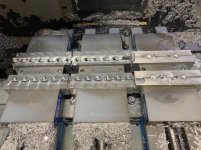I'm cutting the vise jaws for a production run of 200 small parts. I want to hold 15 parts across a 10" vise jaw. I've done this in the past with 6" jaws but if one or two of the parts are say, .002-.003 out of tolerance, the shorter parts come out of the vise.
My thought is to use a plastic material on the front vise jaw to allow a little compression and take up any slack. There's very little machining force on the part for this second operation.
I picked up some Delrin to try, (this is my first experience with Delrin,) but now that I have the Delrin on the bench, it seems almost as hard as 6061.
Do you think the Delrin will compress enough or do I need to look into a different resin material?
Thanks!
gm.
My thought is to use a plastic material on the front vise jaw to allow a little compression and take up any slack. There's very little machining force on the part for this second operation.
I picked up some Delrin to try, (this is my first experience with Delrin,) but now that I have the Delrin on the bench, it seems almost as hard as 6061.
Do you think the Delrin will compress enough or do I need to look into a different resin material?
Thanks!
gm.








